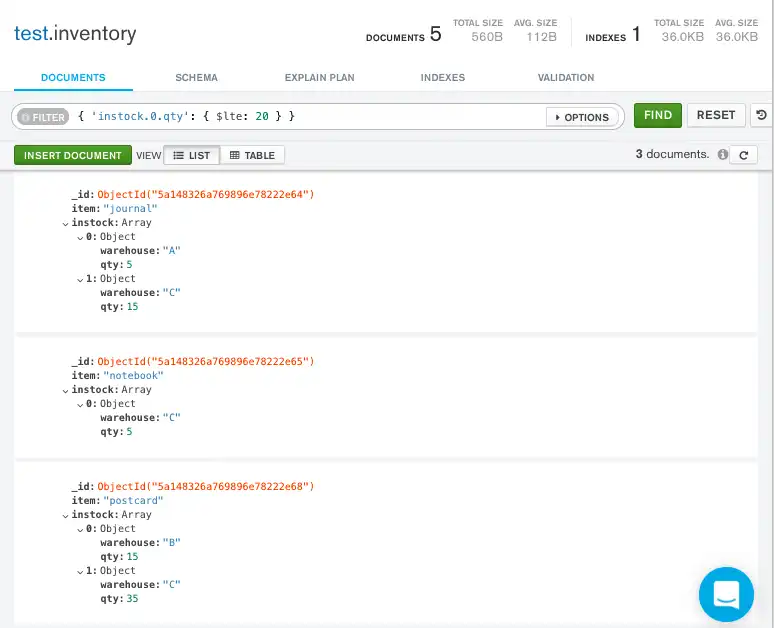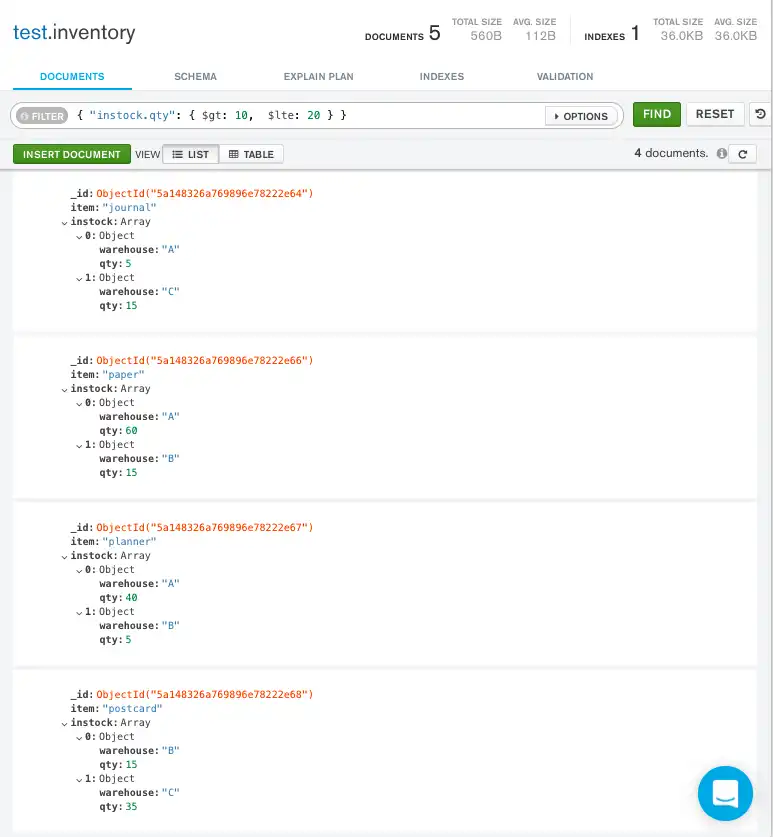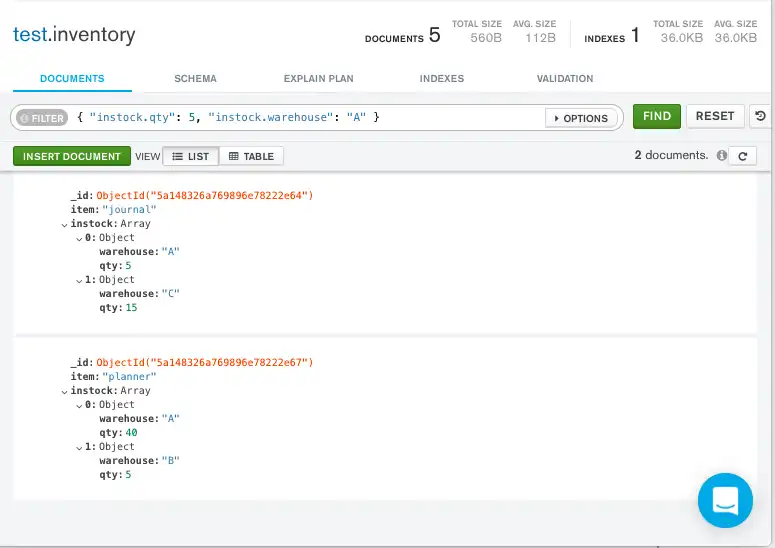查询嵌入式文档数组
您可以使用以下方法查询MongoDB中的文档:
您的编程语言的驱动程序。
MongoDB Atlas 用户界面。要了解更多信息,请参阅使用 MongoDB Atlas 查询文档阵列。
➤ 使用右上角的 Select your language(选择语言)下拉菜单,设置以下示例的语言或选择 MongoDB Compass。
此页面中的示例展示了在 mongosh 中使用 db.collection.find() 方法对嵌套文档数组执行查询操作。
此页面上的示例使用的是 inventory 集合。连接到 MongoDB 实例中的测试数据库,然后创建 inventory 集合:
本页面中的示例展示了使用 MongoDB Compass 对嵌套文档数组执行查询操作。
此页面上的示例使用的是 inventory 集合。连接到 MongoDB 实例中的测试数据库,然后创建 inventory 集合:
本页面提供了使用 MongoDB C# 驱动程序 中的 MongoCollection.Find() 方法对嵌套文档数组进行查询操作的示例。
此页面上的示例使用的是 inventory 集合。连接到 MongoDB 实例中的测试数据库,然后创建 inventory 集合:
本页面中的示例展示了使用 MongoDB Go Driver 中的 Collection.Find 函数对嵌套文档数组进行查询操作。
此页面上的示例使用的是 inventory 集合。连接到 MongoDB 实例中的测试数据库,然后创建 inventory 集合:
本页面中的示例展示了使用 MongoDB Java Reactive Streams 驱动程序中的 com.mongodb.reactivestreams.client.MongoCollection.find 方法对嵌套文档数组执行查询操作。
此页面上的示例使用的是 inventory 集合。连接到 MongoDB 实例中的测试数据库,然后创建 inventory 集合:
此页面中的示例展示了使用 MongoDB Java 同步驱动程序中的 com.mongodb.client.MongoCollection.find 方法对嵌套文档数组执行的查询操作。
提示
此驱动程序提供了 com.mongodb.client.model.Filters 辅助方法,以便于创建过滤器文档。此页面中的示例使用这些方法创建过滤器文档。
此页面上的示例使用的是 inventory 集合。连接到 MongoDB 实例中的测试数据库,然后创建 inventory 集合:
此页面中的示例展示了使用 Motor 驱动程序中的 motor.motor_asyncio.AsyncIOMotorCollection.find 方法对嵌套文档数组执行查询操作。
此页面上的示例使用的是 inventory 集合。连接到 MongoDB 实例中的测试数据库,然后创建 inventory 集合:
本页面提供的示例展示使用 Collection.find() 方法在 MongoDB Node.js 驱动程序 中对嵌套文档的数组执行查询操作。
此页面上的示例使用的是 inventory 集合。连接到 MongoDB 实例中的测试数据库,然后创建 inventory 集合:
此页面中的示例展示了使用 MongoDB PHP 库中的 MongoDB\\Collection::find() 方法对嵌套文档的数组执行查询操作。
此页面上的示例使用的是 inventory 集合。连接到 MongoDB 实例中的测试数据库,然后创建 inventory 集合:
本页提供的示例展示了使用 对嵌套文档大量执行查询操作pymongo.collection.Collection.find PyMongo Python驾驶员中的方法。
此页面上的示例使用的是 inventory 集合。连接到 MongoDB 实例中的测试数据库,然后创建 inventory 集合:
本页面提供的示例展示使用 Collection.find() 方法在 MongoDB Scala 驱动程序中执行查询操作。
此页面上的示例使用的是 inventory 集合。连接到 MongoDB 实例中的测试数据库,然后创建 inventory 集合:
db.inventory.insertMany( [ { item: "journal", instock: [ { warehouse: "A", qty: 5 }, { warehouse: "C", qty: 15 } ] }, { item: "notebook", instock: [ { warehouse: "C", qty: 5 } ] }, { item: "paper", instock: [ { warehouse: "A", qty: 60 }, { warehouse: "B", qty: 15 } ] }, { item: "planner", instock: [ { warehouse: "A", qty: 40 }, { warehouse: "B", qty: 5 } ] }, { item: "postcard", instock: [ { warehouse: "B", qty: 15 }, { warehouse: "C", qty: 35 } ] } ]);
[ { "item": "journal", "instock": [ { "warehouse": "A", "qty": 5 }, { "warehouse": "C", "qty": 15 } ] }, { "item": "notebook", "instock": [ { "warehouse": "C", "qty": 5 } ] }, { "item": "paper", "instock": [ { "warehouse": "A", "qty": 60 }, { "warehouse": "B", "qty": 15 } ] }, { "item": "planner", "instock": [ { "warehouse": "A", "qty": 40 }, { "warehouse": "B", "qty": 5 } ] }, { "item": "postcard", "instock": [ { "warehouse": "B","qty": 15 }, { "warehouse": "C", "qty": 35 } ] } ]
有关在 MongoDB Compass 中插入文档的说明,请参阅插入文档。
var documents = new[] { new BsonDocument { { "item", "journal" }, { "instock", new BsonArray { new BsonDocument { { "warehouse", "A" }, { "qty", 5 } }, new BsonDocument { { "warehouse", "C" }, { "qty", 15 } } } } }, new BsonDocument { { "item", "notebook" }, { "instock", new BsonArray { new BsonDocument { { "warehouse", "C" }, { "qty", 5 } } } } }, new BsonDocument { { "item", "paper" }, { "instock", new BsonArray { new BsonDocument { { "warehouse", "A" }, { "qty", 60 } }, new BsonDocument { { "warehouse", "B" }, { "qty", 15 } } } } }, new BsonDocument { { "item", "planner" }, { "instock", new BsonArray { new BsonDocument { { "warehouse", "A" }, { "qty", 40 } }, new BsonDocument { { "warehouse", "B" }, { "qty", 5 } } } } }, new BsonDocument { { "item", "postcard" }, { "instock", new BsonArray { new BsonDocument { { "warehouse", "B" }, { "qty", 15 } }, new BsonDocument { { "warehouse", "C" }, { "qty", 35 } } } } } }; collection.InsertMany(documents);
docs := []interface{}{ bson.D{ {"item", "journal"}, {"instock", bson.A{ bson.D{ {"warehouse", "A"}, {"qty", 5}, }, bson.D{ {"warehouse", "C"}, {"qty", 15}, }, }}, }, bson.D{ {"item", "notebook"}, {"instock", bson.A{ bson.D{ {"warehouse", "C"}, {"qty", 5}, }, }}, }, bson.D{ {"item", "paper"}, {"instock", bson.A{ bson.D{ {"warehouse", "A"}, {"qty", 60}, }, bson.D{ {"warehouse", "B"}, {"qty", 15}, }, }}, }, bson.D{ {"item", "planner"}, {"instock", bson.A{ bson.D{ {"warehouse", "A"}, {"qty", 40}, }, bson.D{ {"warehouse", "B"}, {"qty", 5}, }, }}, }, bson.D{ {"item", "postcard"}, {"instock", bson.A{ bson.D{ {"warehouse", "B"}, {"qty", 15}, }, bson.D{ {"warehouse", "C"}, {"qty", 35}, }, }}, }, } result, err := coll.InsertMany(context.TODO(), docs)
Publisher<Success> insertManyPublisher = collection.insertMany(asList( Document.parse("{ item: 'journal', instock: [ { warehouse: 'A', qty: 5 }, { warehouse: 'C', qty: 15 } ] }"), Document.parse("{ item: 'notebook', instock: [ { warehouse: 'C', qty: 5 } ] }"), Document.parse("{ item: 'paper', instock: [ { warehouse: 'A', qty: 60 }, { warehouse: 'B', qty: 15 } ] }"), Document.parse("{ item: 'planner', instock: [ { warehouse: 'A', qty: 40 }, { warehouse: 'B', qty: 5 } ] }"), Document.parse("{ item: 'postcard', instock: [ { warehouse: 'B', qty: 15 }, { warehouse: 'C', qty: 35 } ] }") ));
collection.insertMany(asList( Document.parse("{ item: 'journal', instock: [ { warehouse: 'A', qty: 5 }, { warehouse: 'C', qty: 15 } ] }"), Document.parse("{ item: 'notebook', instock: [ { warehouse: 'C', qty: 5 } ] }"), Document.parse("{ item: 'paper', instock: [ { warehouse: 'A', qty: 60 }, { warehouse: 'B', qty: 15 } ] }"), Document.parse("{ item: 'planner', instock: [ { warehouse: 'A', qty: 40 }, { warehouse: 'B', qty: 5 } ] }"), Document.parse("{ item: 'postcard', instock: [ { warehouse: 'B', qty: 15 }, { warehouse: 'C', qty: 35 } ] }") ));
# Subdocument key order matters in a few of these examples so we have # to use bson.son.SON instead of a Python dict. from bson.son import SON await db.inventory.insert_many( [ { "item": "journal", "instock": [ SON([("warehouse", "A"), ("qty", 5)]), SON([("warehouse", "C"), ("qty", 15)]), ], }, {"item": "notebook", "instock": [SON([("warehouse", "C"), ("qty", 5)])]}, { "item": "paper", "instock": [ SON([("warehouse", "A"), ("qty", 60)]), SON([("warehouse", "B"), ("qty", 15)]), ], }, { "item": "planner", "instock": [ SON([("warehouse", "A"), ("qty", 40)]), SON([("warehouse", "B"), ("qty", 5)]), ], }, { "item": "postcard", "instock": [ SON([("warehouse", "B"), ("qty", 15)]), SON([("warehouse", "C"), ("qty", 35)]), ], }, ] )
await db.collection('inventory').insertMany([ { item: 'journal', instock: [ { warehouse: 'A', qty: 5 }, { warehouse: 'C', qty: 15 } ] }, { item: 'notebook', instock: [{ warehouse: 'C', qty: 5 }] }, { item: 'paper', instock: [ { warehouse: 'A', qty: 60 }, { warehouse: 'B', qty: 15 } ] }, { item: 'planner', instock: [ { warehouse: 'A', qty: 40 }, { warehouse: 'B', qty: 5 } ] }, { item: 'postcard', instock: [ { warehouse: 'B', qty: 15 }, { warehouse: 'C', qty: 35 } ] } ]);
$insertManyResult = $db->inventory->insertMany([ [ 'item' => 'journal', 'instock' => [ ['warehouse' => 'A', 'qty' => 5], ['warehouse' => 'C', 'qty' => 15], ], ], [ 'item' => 'notebook', 'instock' => [ ['warehouse' => 'C', 'qty' => 5], ], ], [ 'item' => 'paper', 'instock' => [ ['warehouse' => 'A', 'qty' => 60], ['warehouse' => 'B', 'qty' => 15], ], ], [ 'item' => 'planner', 'instock' => [ ['warehouse' => 'A', 'qty' => 40], ['warehouse' => 'B', 'qty' => 5], ], ], [ 'item' => 'postcard', 'instock' => [ ['warehouse' => 'B', 'qty' => 15], ['warehouse' => 'C', 'qty' => 35], ], ], ]);
db.inventory.insert_many( [ { "item": "journal", "instock": [ {"warehouse": "A", "qty": 5}, {"warehouse": "C", "qty": 15}, ], }, {"item": "notebook", "instock": [{"warehouse": "C", "qty": 5}]}, { "item": "paper", "instock": [ {"warehouse": "A", "qty": 60}, {"warehouse": "B", "qty": 15}, ], }, { "item": "planner", "instock": [ {"warehouse": "A", "qty": 40}, {"warehouse": "B", "qty": 5}, ], }, { "item": "postcard", "instock": [ {"warehouse": "B", "qty": 15}, {"warehouse": "C", "qty": 35}, ], }, ] )
client[:inventory].insert_many([{ item: 'journal', instock: [ { warehouse: 'A', qty: 5 }, { warehouse: 'C', qty: 15 }] }, { item: 'notebook', instock: [ { warehouse: 'C', qty: 5 }] }, { item: 'paper', instock: [ { warehouse: 'A', qty: 60 }, { warehouse: 'B', qty: 15 }] }, { item: 'planner', instock: [ { warehouse: 'A', qty: 40 }, { warehouse: 'B', qty: 5 }] }, { item: 'postcard', instock: [ { warehouse: 'B', qty: 15 }, { warehouse: 'C', qty: 35 }] } ])
collection.insertMany(Seq( Document("""{ item: "journal", instock: [ { warehouse: "A", qty: 5 }, { warehouse: "C", qty: 15 } ] }"""), Document("""{ item: "notebook", instock: [ { warehouse: "C", qty: 5 } ] }"""), Document("""{ item: "paper", instock: [ { warehouse: "A", qty: 60 }, { warehouse: "B", qty: 15 } ] }"""), Document("""{ item: "planner", instock: [ { warehouse: "A", qty: 40 }, { warehouse: "B", qty: 5 } ] }"""), Document("""{ item: "postcard", instock: [ { warehouse: "B", qty: 15 }, { warehouse: "C", qty: 35 } ] }""") )).execute()
查询嵌套在数组中的文档
以下示例选择 instock 数组中的元素与指定文档匹配的所有文档:
db.inventory.find( { "instock": { warehouse: "A", qty: 5 } } )
将以下过滤器复制到 Compass 查询栏中,然后单击 Find:
{ "instock": { warehouse: "A", qty: 5 } }
var filter = Builders<BsonDocument>.Filter.AnyEq("instock", new BsonDocument { { "warehouse", "A" }, { "qty", 5 } }); var result = collection.Find(filter).ToList();
cursor, err := coll.Find( context.TODO(), bson.D{ {"instock", bson.D{ {"warehouse", "A"}, {"qty", 5}, }}, })
FindPublisher<Document> findPublisher = collection.find(eq("instock", Document.parse("{ warehouse: 'A', qty: 5 }")));
FindIterable<Document> findIterable = collection.find(eq("instock", Document.parse("{ warehouse: 'A', qty: 5 }")));
cursor = db.inventory.find({"instock": SON([("warehouse", "A"), ("qty", 5)])})
const cursor = db.collection('inventory').find({ instock: { warehouse: 'A', qty: 5 } });
$cursor = $db->inventory->find(['instock' => ['warehouse' => 'A', 'qty' => 5]]);
cursor = db.inventory.find({"instock": {"warehouse": "A", "qty": 5}})
client[:inventory].find(instock: { warehouse: 'A', qty: 5 })
var findObservable = collection.find(equal("instock", Document("warehouse" -> "A", "qty" -> 5)))
整个嵌入式/嵌套文档的相等匹配要求与指定文档精确匹配,包括字段顺序。例如,以下查询不匹配 inventory 集合中的任何文档:
db.inventory.find( { "instock": { qty: 5, warehouse: "A" } } )
var filter = Builders<BsonDocument>.Filter.AnyEq("instock", new BsonDocument { { "qty", 5 }, { "warehouse", "A" } }); var result = collection.Find(filter).ToList();
cursor, err := coll.Find( context.TODO(), bson.D{ {"instock", bson.D{ {"qty", 5}, {"warehouse", "A"}, }}, })
findPublisher = collection.find(eq("instock", Document.parse("{ qty: 5, warehouse: 'A' }")));
findIterable = collection.find(eq("instock", Document.parse("{ qty: 5, warehouse: 'A' }")));
cursor = db.inventory.find({"instock": SON([("qty", 5), ("warehouse", "A")])})
const cursor = db.collection('inventory').find({ instock: { qty: 5, warehouse: 'A' } });
$cursor = $db->inventory->find(['instock' => ['qty' => 5, 'warehouse' => 'A']]);
cursor = db.inventory.find({"instock": {"qty": 5, "warehouse": "A"}})
client[:inventory].find(instock: { qty: 5, warehouse: 'A' } )
findObservable = collection.find(equal("instock", Document("qty" -> 5, "warehouse" -> "A")))
在文档数组中的字段上指定查询条件
在文档数组中嵌入的字段上指定查询条件
如果您不知道嵌套在数组中的文档的索引位置,请使用点 (.) 来连接数组字段的名称以及嵌套文档中的字段名称。
以下示例选择满足下列条件的所有文档——instock 数组至少有一份嵌入式文档包含字段 qty 且其值小于或等于 20:
db.inventory.find( { 'instock.qty': { $lte: 20 } } )
将以下过滤器复制到 Compass 查询栏中,然后单击 Find:
{ 'instock.qty': { $lte: 20 } }

var filter = Builders<BsonDocument>.Filter.Lte("instock.qty", 20); var result = collection.Find(filter).ToList();
cursor, err := coll.Find( context.TODO(), bson.D{ {"instock.qty", bson.D{ {"$lte", 20}, }}, })
findPublisher = collection.find(lte("instock.qty", 20));
findIterable = collection.find(lte("instock.qty", 20));
cursor = db.inventory.find({"instock.qty": {"$lte": 20}})
const cursor = db.collection('inventory').find({ 'instock.qty': { $lte: 20 } });
$cursor = $db->inventory->find(['instock.qty' => ['$lte' => 20]]);
cursor = db.inventory.find({"instock.qty": {"$lte": 20}})
client[:inventory].find('instock.qty' => { '$lte' => 20 })
findObservable = collection.find(lte("instock.qty", 20))
使用数组索引查询嵌入式文档中的字段
使用点符号,可以在数组的特定索引或位置为文档中的字段指定查询条件。该数组使用从零开始的索引。
注意
使用点符号查询时,字段和索引必须位于引号内。
以下示例选择所有满足如下条件的文档——instock 数组的第一个元素是包含值小于或等于 20 的 qty 字段的文档:
db.inventory.find( { 'instock.0.qty': { $lte: 20 } } )
将以下过滤器复制到 Compass 查询栏中,然后单击 Find:
{ 'instock.0.qty': { $lte: 20 } }

var filter = Builders<BsonDocument>.Filter.Lte("instock.0.qty", 20); var result = collection.Find(filter).ToList();
cursor, err := coll.Find( context.TODO(), bson.D{ {"instock.0.qty", bson.D{ {"$lte", 20}, }}, })
findPublisher = collection.find(lte("instock.0.qty", 20));
findIterable = collection.find(lte("instock.0.qty", 20));
cursor = db.inventory.find({"instock.0.qty": {"$lte": 20}})
const cursor = db.collection('inventory').find({ 'instock.0.qty': { $lte: 20 } });
$cursor = $db->inventory->find(['instock.0.qty' => ['$lte' => 20]]);
cursor = db.inventory.find({"instock.0.qty": {"$lte": 20}})
client[:inventory].find('instock.0.qty' => { '$lte' => 20 })
findObservable = collection.find(lte("instock.0.qty", 20))
为文档数组指定多个条件
对嵌套在文档数组中的多个字段指定条件时,可指定查询,以使单个文档满足这些条件,或使数组中任意文档(包括单个文档)的组合满足这些条件。
单个嵌套文档满足嵌套字段的多个查询条件
使用 $elemMatch 操作符在大量嵌入式文档中指定多个条件,以使至少一个嵌入式文档满足所有指定条件。
以下示例查询满足如下条件的文档——instock 数组至少有一份嵌入式文档,该文档同时包含等于 5 的字段 qty 和等于 A 的字段 warehouse:
db.inventory.find( { "instock": { $elemMatch: { qty: 5, warehouse: "A" } } } )
将以下过滤器复制到 Compass 查询栏中,然后单击 Find:
{ "instock": { $elemMatch: { qty: 5, warehouse: "A" } } }
var filter = Builders<BsonDocument>.Filter.ElemMatch<BsonValue>("instock", new BsonDocument { { "qty", 5 }, { "warehouse", "A" } }); var result = collection.Find(filter).ToList();
cursor, err := coll.Find( context.TODO(), bson.D{ {"instock", bson.D{ {"$elemMatch", bson.D{ {"qty", 5}, {"warehouse", "A"}, }}, }}, })
findPublisher = collection.find(elemMatch("instock", Document.parse("{ qty: 5, warehouse: 'A' }")));
findIterable = collection.find(elemMatch("instock", Document.parse("{ qty: 5, warehouse: 'A' }")));
cursor = db.inventory.find({"instock": {"$elemMatch": {"qty": 5, "warehouse": "A"}}})
const cursor = db.collection('inventory').find({ instock: { $elemMatch: { qty: 5, warehouse: 'A' } } });
$cursor = $db->inventory->find(['instock' => ['$elemMatch' => ['qty' => 5, 'warehouse' => 'A']]]);
cursor = db.inventory.find({"instock": {"$elemMatch": {"qty": 5, "warehouse": "A"}}})
client[:inventory].find(instock: { '$elemMatch' => { qty: 5, warehouse: 'A' } })
findObservable = collection.find(elemMatch("instock", Document("qty" -> 5, "warehouse" -> "A")))
以下示例将查询 instock 数组至少包含一个嵌入文档,且该文档包含大于 qty 且小于或等于 20 的字段 10:
db.inventory.find( { "instock": { $elemMatch: { qty: { $gt: 10, $lte: 20 } } } } )
将以下过滤器复制到 Compass 查询栏中,然后单击 Find:
{ "instock": { $elemMatch: { qty: { $gt: 10, $lte: 20 } } } }
var filter = Builders<BsonDocument>.Filter.ElemMatch<BsonValue>("instock", new BsonDocument { { "qty", new BsonDocument { { "$gt", 10 }, { "$lte", 20 } } } }); var result = collection.Find(filter).ToList();
cursor, err := coll.Find( context.TODO(), bson.D{ {"instock", bson.D{ {"$elemMatch", bson.D{ {"qty", bson.D{ {"$gt", 10}, {"$lte", 20}, }}, }}, }}, })
findPublisher = collection.find(elemMatch("instock", Document.parse("{ qty: { $gt: 10, $lte: 20 } }")));
findIterable = collection.find(elemMatch("instock", Document.parse("{ qty: { $gt: 10, $lte: 20 } }")));
cursor = db.inventory.find({"instock": {"$elemMatch": {"qty": {"$gt": 10, "$lte": 20}}}})
const cursor = db.collection('inventory').find({ instock: { $elemMatch: { qty: { $gt: 10, $lte: 20 } } } });
$cursor = $db->inventory->find(['instock' => ['$elemMatch' => ['qty' => ['$gt' => 10, '$lte' => 20]]]]);
cursor = db.inventory.find({"instock": {"$elemMatch": {"qty": {"$gt": 10, "$lte": 20}}}})
client[:inventory].find(instock: { '$elemMatch' => { qty: { '$gt' => 10, '$lte' => 20 } } })
findObservable = collection.find(elemMatch("instock", Document("""{ qty: { $gt: 10, $lte: 20 } }""")))
组合满足标准的元素
如果数组字段上的复合查询条件没有使用 $elemMatch 操作符,则查询会选择如下文档:数组中包含满足条件的任意元素的组合。
例如,以下查询匹配如下文档:嵌套在 instock 数组内的任何文档的 qty 字段大于 10 且该数组中的任何文档(不一定是同一份嵌入式文档)的 qty 字段小于或等于 20:
db.inventory.find( { "instock.qty": { $gt: 10, $lte: 20 } } )
将以下过滤器复制到 Compass 查询栏中,然后单击 Find:
{ "instock.qty": { $gt: 10, $lte: 20 } }

var builder = Builders<BsonDocument>.Filter; var filter = builder.And(builder.Gt("instock.qty", 10), builder.Lte("instock.qty", 20)); var result = collection.Find(filter).ToList();
cursor, err := coll.Find( context.TODO(), bson.D{ {"instock.qty", bson.D{ {"$gt", 10}, {"$lte", 20}, }}, })
findPublisher = collection.find(and(gt("instock.qty", 10), lte("instock.qty", 20)));
findIterable = collection.find(and(gt("instock.qty", 10), lte("instock.qty", 20)));
cursor = db.inventory.find({"instock.qty": {"$gt": 10, "$lte": 20}})
const cursor = db.collection('inventory').find({ 'instock.qty': { $gt: 10, $lte: 20 } });
$cursor = $db->inventory->find(['instock.qty' => ['$gt' => 10, '$lte' => 20]]);
cursor = db.inventory.find({"instock.qty": {"$gt": 10, "$lte": 20}})
client[:inventory].find('instock.qty' => { '$gt' => 10, '$lte' => 20 })
findObservable = collection.find(and(gt("instock.qty", 10), lte("instock.qty", 20)))
以下示例查询符合以下条件的文档 — instock 数组至少有一个包含等于 5 的字段 qty 的嵌入式文档,以及至少一个包含等于 A 的字段 warehouse 的嵌入式文档(但不一定是同一个嵌入式文档):
db.inventory.find( { "instock.qty": 5, "instock.warehouse": "A" } )
将以下过滤器复制到 Compass 查询栏中,然后单击 Find:
{ "instock.qty": 5, "instock.warehouse": "A" }

var builder = Builders<BsonDocument>.Filter; var filter = builder.And(builder.Eq("instock.qty", 5), builder.Eq("instock.warehouse", "A")); var result = collection.Find(filter).ToList();
cursor, err := coll.Find( context.TODO(), bson.D{ {"instock.qty", 5}, {"instock.warehouse", "A"}, })
findPublisher = collection.find(and(eq("instock.qty", 5), eq("instock.warehouse", "A")));
findIterable = collection.find(and(eq("instock.qty", 5), eq("instock.warehouse", "A")));
cursor = db.inventory.find({"instock.qty": 5, "instock.warehouse": "A"})
const cursor = db.collection('inventory').find({ 'instock.qty': 5, 'instock.warehouse': 'A' });
$cursor = $db->inventory->find(['instock.qty' => 5, 'instock.warehouse' => 'A']);
cursor = db.inventory.find({"instock.qty": 5, "instock.warehouse": "A"})
client[:inventory].find('instock.qty' => 5, 'instock.warehouse' => 'A')
findObservable = collection.find(and(equal("instock.qty", 5), equal("instock.warehouse", "A")))
使用 MongoDB Atlas 查询文档数组
本节中的示例使用示例训练数据集。要了解如何将示例数据集加载到您的 MongoDB Atlas 部署中,请参阅加载示例数据。
要在 MongoDB Atlas 中查询文档数组,请按照以下步骤操作:
单击 Apply
此查询过滤器返回 sample_training.grades 集合中包含 scores 数组中子文档的所有文档,其中 type 设置为 exam。将返回包括整个 scores 数组在内的完整文档。有关修改返回数组的更多信息,请参阅已返回数组中特定于项目的数组元素。
其他查询教程
有关其他查询示例,请参阅: